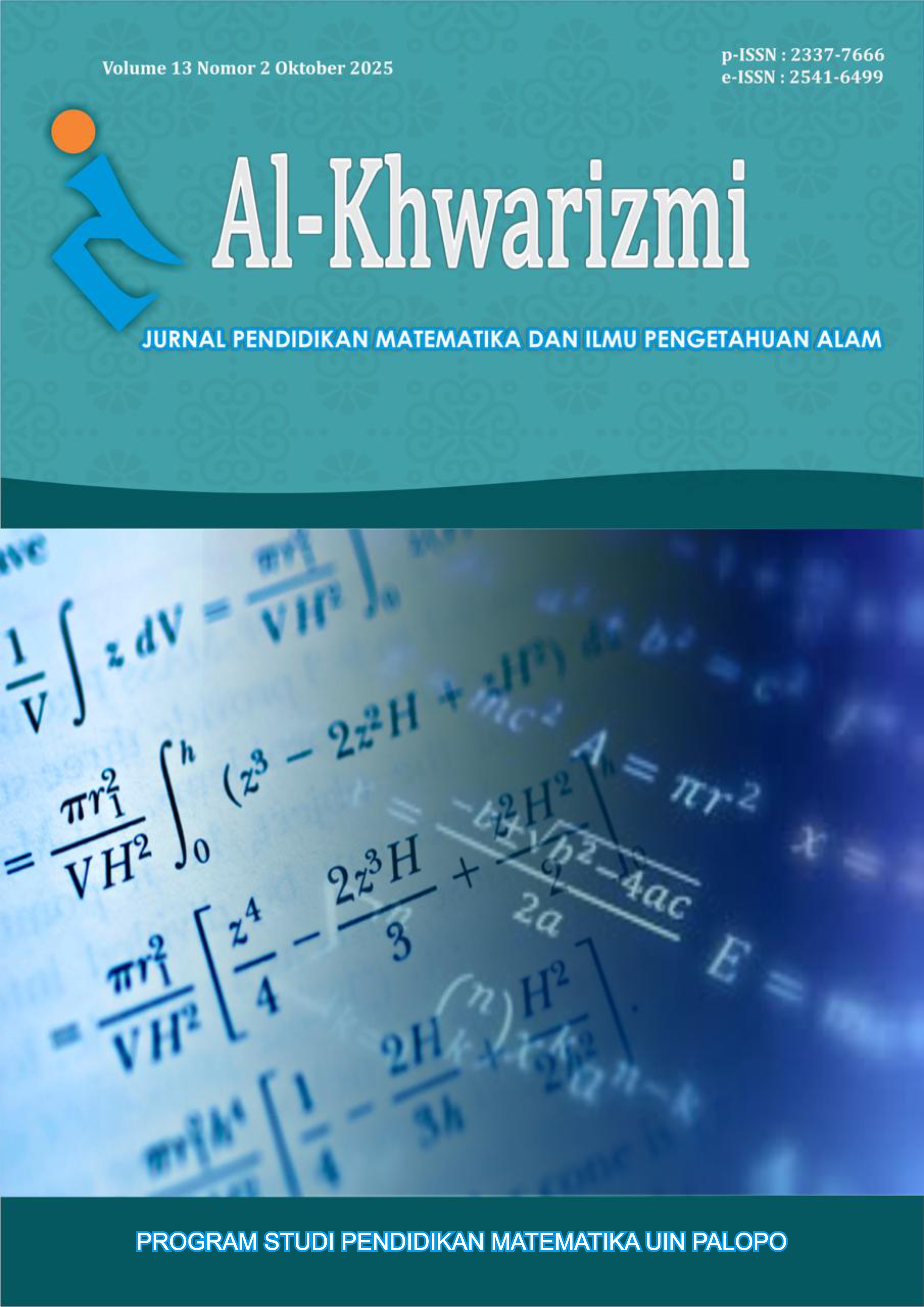Peningkatan Kemampuan Berpikir Kreatif melalui Pendekatan Pendidikan Matematika Realistik Indonesia pada Materi Lingkaran
Keywords:
Berpikir Kreatif, Lingkaran, Matematika Realistik, Pembelajaran MatematikaAbstract
Abstract:
Abstrak:
References
Alim, Jesi Alexander, Ahmad Fauzan, I Made Arwana, and Edwin Musdi. “Model of Geometry Realistic Learning Development with Interactive Multimedia Assistance in Elementary School.” Journal of Physics: Conference Series 1471, no. 1 (2020): 012053. https://doi.org/10.1088/1742-6596/1471/1/012053.
Arikunto, Suharsimi, and Suhardjono Supardi. Penelitian Tindakan Kelas: Edisi Revisi. Bumi Aksara, 2021.
Davis, Kirsten A., Dustin Grote, Hesam Mahmoudi, et al. “Comparing Self-Report Assessments and Scenario-Based Assessments of Systems Thinking Competence.” Journal of Science Education and Technology 32, no. 6 (2023): 793–813. https://doi.org/10.1007/s10956-023-10027-2.
Do, Thi-Trinh, Phan Thi Tinh, Ha-Giang Tran-Thi, et al. “Research on Lifelong Learning in Southeast Asia: A Bibliometrics Review between 1972 and 2019.” Cogent Education 8, no. 1 (2021): 1994361. https://doi.org/10.1080/2331186X.2021.1994361.
Erni Yuniar, Dase Erwin Juansah, and Ila Rosmilawati. “Efektivitas Penerapan Pendekatan STEM Dalam Mengembangkan Keterampilan Berpikir Kritis Dan Kreatif Pada Siswa Sekolah Dasar.” ResearchGate, ahead of print, September 28, 2025. https://doi.org/10.31004/basicedu.v9i4.10013.
Fajri, Hadrian Mei, Arita Marini, and Suyono. “Trends and Patterns in Realistic Mathematics Education Research in Elementary Schools: A Bibliometric Approach.” Social Sciences & Humanities Open 12 (January 2025): 101730. https://doi.org/10.1016/j.ssaho.2025.101730.
Fredriksen, Helge. “Exploring Realistic Mathematics Education in a Flipped Classroom Context at the Tertiary Level.” International Journal of Science and Mathematics Education 19, no. 2 (2021): 377–96. https://doi.org/10.1007/s10763-020-10053-1.
Hakim, Titi Adriani, and Wahyu Setyaningrum. “Realistic Mathematics Education Combined with Guided Discovery for Improving Middle School Students’ Statistical Literacy.” Journal of Honai Math 7, no. 2 (2024): 233–46.
Herlinawati, Herlinawati, Marwa Marwa, Noriah Ismail, Junaidi, Ledya Oktavia Liza, and Dominikus David Biondi Situmorang. “The Integration of 21st Century Skills in the Curriculum of Education.” Heliyon 10, no. 15 (2024): e35148. https://doi.org/10.1016/j.heliyon.2024.e35148.
Izzati, Aulia Al Tsani, Siti Faizah, and Mardhatillah Mardhatillah. Validated HOTS-Based Worksheets Enhance Higher-Order Thinking Skills and Impact Geometry Learning Outcomes. n.d.
Kartikasari, Isnaeni Aprilia, Budi Usodo, and Riyadi. “The Effectiveness Open-Ended Learning and Creative Problem Solving Models to Improve Creative Thinking Skills.” Pegem Journal of Education and Instruction 12, no. 4 (2022): 29–38. https://doi.org/10.47750/pegegog.12.04.04.
Phan, Tinh Thi, Thi Trinh Do, Thanh Hai Trinh, et al. “A Bibliometric Review on Realistic Mathematics Education in Scopus Database Between 1972-2019.” European Journal of Educational Research 11, no. 2 (2022): 1133–49. https://doi.org/10.12973/eu-jer.11.2.1133.
Ramadhan Safrudin,Sri Dewi Priwarti Siregar,Tarek Yalouli. “The Development Of Higher-Order Thinking Skills Assessments:, A Bibliometric Analysis.” ResearchGate, ahead of print, October 9, 2025. https://doi.org/10.35393/1730-011-001-011.
Ramadhanta, Sury Adellia, Rustam Effendy Simamora, and Dwi Susanti. “Enhancing Mathematical Creative Thinking Ability: Experimentation With Realistic Mathematics Education By Embedding Ice Breaking In Junior High School.” Edu-Mat: Jurnal Pendidikan Matematika 12, no. 1 (2024): 47–66.
Safrudin, Ramadhan. “The Development of Higher-Order Thinking Skills Assessments: A Bibliometric Analysis.” Revue Des Sciences Humaines & Sociales, January 1, 2025. https://www.academia.edu/129946659/The_Development_of_Higher_order_Thinking_Skills_Assessments_A_Bibliometric_Analysis.
Septiani, Syilvia, and Kana Hidayati. “The Effect of a Creative-Problem Solving Learning Model Based on an Open-Ended Approach Toward High Level of Mathematical Thinking Ability of Students.” Al-Khwarizmi : Jurnal Pendidikan Matematika Dan Ilmu Pengetahuan Alam 12, no. 2 (2024): 123–36. https://doi.org/10.24256/jpmipa.v12i2.5281.
Sipahi, Yasemin, and A. Kadir Bahar. “Mathematical Creativity: A Systematic Review of Definitions, Frameworks, and Assessment Practices.” Education Sciences 15, no. 10 (2025): 1348. https://doi.org/10.3390/educsci15101348.
Sipayung, T. N., S. D. Simanjuntak, A. Wijaya, and S. Sugiman. “The Effect of Comic-Based Realistic Mathematics Approach on Students’ Learning Motivation and Conceptual Understanding.” Journal of Physics: Conference Series 1538, no. 1 (2020). https://doi.org/10.1088/1742-6596/1538/1/012111.
Suwanto, Fevi Rahmawati, Ariyadi Wijaya, Aprisal Aprisal, Asri Fauzi, and Yunda Victorina Tobondo. “Realistic Mathematics Textbook Toward The Students’ Mathematical Generalization Skills.” Mosharafa: Jurnal Pendidikan Matematika 12, no. 2 (2023): 291–300. https://doi.org/10.31980/mosharafa.v12i2.2617.
Wawan, Wawan, Heri Retnawati, and Wahyu Setyaningrum. “An Integrative Learning Model to Improve Problem-Solving and Creative Thinking Abilities, Collaboration, and Motivation.” Islamic Guidance and Counseling Journal 6, no. 2 (2023). https://doi.org/10.25217/0020236402400.
Downloads
Published
How to Cite
Issue
Section
Citation Check
License
Copyright (c) 2025 Al-Khwarizmi : Jurnal Pendidikan Matematika dan Ilmu Pengetahuan Alam

This work is licensed under a Creative Commons Attribution-ShareAlike 4.0 International License.
Authors who wish to publish and disseminate their papers with the Al-Khwarizmi : Jurnal Pendidikan Matematika dan Ilmu Pengetahuan Alam, shall agree to the publishing rights set by Al-Khwarizmi : Jurnal Pendidikan Matematika dan Ilmu Pengetahuan Alam. Authors understand that they shall assign publication rights as part of the process upon acceptance for publication. The authors agreed that they would transfer certain copyrights to Al-Khwarizmi : Jurnal Pendidikan Matematika dan Ilmu Pengetahuan Alam. Consecutively, authors still retain some rights to use and share their own published articles without written permission from Al-Khwarizmi : Jurnal Pendidikan Matematika dan Ilmu Pengetahuan Alam.
Authors granted Al-Khwarizmi : Jurnal Pendidikan Matematika dan Ilmu Pengetahuan Alam the following rights; (1) the right to publish and provide the manuscripts in all forms and media for publication and dissemination, (2) the authority to enforce the rights in the manuscript, for example in the case of plagiarism or in copyright infringement.
Al-Khwarizmi : Jurnal Pendidikan Matematika dan Ilmu Pengetahuan Alam will follow COPE's Code of Conduct and Best Practice Guidelines for Journal Editors to protect the research results and take allegations of any infringements, plagiarisms, ethical issues, and frauds should those issues arise. The manuscript is attributed as the authors' work, and is properly identified.







